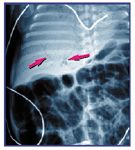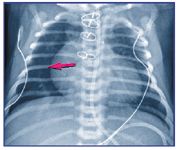Air in all the wrong places: Subtle and not-so-subtle plain radiograph findings
Plain film radiography is an invaluable tool for assessing the newborn with respiratory distress or abdominal distention caused by air in abnormal anatomic locations. Alertness to subtle findings can save an infant's life.
Plain film radiography is the workhorse of imaging in the neonatal intensive care unit and newborn nursery. The technique is portable, minimizing stress for the critically ill newborn, and quick-yielding results in minutes. Moreover, this type of study serves as the initial screen that directs the need for more specialized imaging techniques, such as fluoroscopy, ultrasound, computed tomography (CT), or magnetic resonance imaging (MRI).1

Air in the chest causing respiratory distress
Extra-alveolar air
The presence of extra-alveolar air results from a pressure gradient created by increased intra-alveolar pressure and subsequent rupture of alveoli. Ultimately, air dissects into the perivascular spaces.4 This process may lead to a pneumothorax, pneumomediastinum, or pulmonary interstitial emphysema. The premature neonate is at particular risk because of noncompliant lungs. Diseased or hypoplastic lungs, or lungs subjected to barotrauma from assisted ventilation, are prone to alveolar rupture. A pneumothorax also may occur spontaneously when an infant attempts to overcome tracheobronchial obstruction.2

Air in the pleural space may be under tension, causing a contralateral shift of the mediastinal structures or hemidiaphragmatic inversion on the affected side. In the ventilated neonate, a pneumothorax is assumed to be under tension and almost always requires intervention.5
Newsletter
Access practical, evidence-based guidance to support better care for our youngest patients. Join our email list for the latest clinical updates.